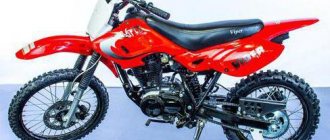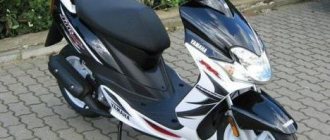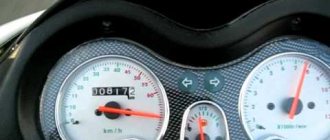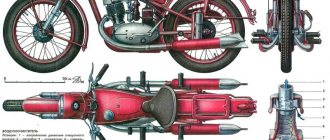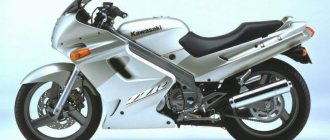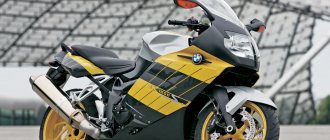Suzuki TL 1000 (TL1000S, TL1000R) motorcycle review
Background, TL 1000 was licked from a liter Ducati in 98. and was produced until 02. If I'm not mistaken, their piston strokes are even millimeter to millimeter). However, the internal combustion engine has a wet clutch, the timing drive is a chain, and there is no desmodrome, so to speak, a Japanese-inspired Ducati.
I want to write a review specifically about the 1000R, they should not be confused with the 1000S. These are 2 almost different motorcycles.
Rka has 2 forces per cylinder, 135 horsepower and very, very high torque. Eska 1. Force has 10 horses less, and the moment is no longer the same. + different frames + different rear suspensions, by the way, the TLR has the only rotary piston strut in the world =) From experience there were R - 2 pieces. and one S. The helmet seemed not at all interesting to me, for those over 40...
So. tl1000r. Tokiko 6-piston brakes are not bad, but not the best. The fit is straight sport, the clip-ons are low, the legs are high - full crooked. The rear strut is a rotary piston, no matter how bad it is, it’s a complete oak, no matter how hard the settings are, it’s still exactly rigid. This could also be called a plus in corners, you can lay it right on the spot, but we are in Russia, there are no perfectly smooth roads - every bump begins to feel unpleasantly as a 5th point =) The motorcycle is generally prone to wobbling, but it comes with a damper from the factory . In appearance it looks like an amateur, the plastic is large and wide. The mounting spider, by the way, is plastic =(((yes, yes, despite the fact that the muzzle protrudes strongly forward and the headlight is quite bulky. Personally, I broke mine during the first hard landing from a wheelie. The engine does not tolerate prolonged wheelies, after 3-4 seconds in the rear, the pressure lamp lights up , the oil flows to the rear, but on the contrary does not flow into the front barrel. Therefore, all these rumors about dying heads are true. This can be treated by making cuts in the crankcase, but again the pan is not removable and to do this, you need to cut half the engine. There is also such a problem as freezing valves at high volume The clutch is hydraulic and often leaks from the release cylinder.
Yes, there are unpleasant shortcomings, but we all have them, some more, some less. In tiller, this covers everything up =) Guys, seriously, the torque is simply amazing, you forget about everything, as soon as the current starts, the locomotive traction begins, you are literally dragged forward, while you sit rigidly, the suspension is stiff and the constant torque is one continuous thrust, in general, this is not a rower for you =) You can love the tielka for this =)
So I waved my Bandit at this miracle from 1997. After 600 it looks great, it brakes great, the head blade picks up speed and the sound of the V2 is amazing, the traction is brutal. And then everyday life went, landing the blade of the back and arms, of course you can get used to it, but riding in traffic jams is normally exhausting You feel yourself only after 140. By the way, the maximum you get is 260. After 240, it picks up 6th gear very slowly, it’s long, there’s a reserve in revs, but it doesn’t pick up, maybe I’m too big, 190 and 100 kg. Cruising on the highway is 160-180 and in this mode you get pleasure, and there is no competition with cars; all attempts are stopped by a slight turn of the throttle. but the engine doesn’t like tops; all the meat is in the middle, and there’s no point in turning it to the cutoff only in the middle, a feature of the narrow V2.
Up to 2500 there is jerking and not driving (despite the injector) and then about 3500-4000 there is a jerk with access to the rear and a low roar of forward flow (for others it’s beautiful, but for me it’s scary) and the line between not driving, I jerk, make strange sounds and tear into full force is very thin, starting from a traffic light, you often pass a zebra crossing (in many places in our country it looks like a plastic covering) with slipping, which is why it was called the best wheelie bike, and some are a widowmaker. Well, locking the rear wheel when shifting down to 2.1 gears with the rear brake attached is almost unnecessary. Many will say that the same thing happens on other sports liters, but the rowers work more smoothly at low speeds and their pickup is closer to 7000 and not with a sharp transition in a narrow range, and it’s worth saying thank you to Suzuki for tuning the injector.
With the goofy character of the motorcycle, magazines and the Internet did not deceive. They didn’t lie about the “excellent” rear shock absorber breaking the fastenings to the frame; I was happy to see the smile of a crack on the ear of the fastening with the prospect of disassembling the floor of the motor for welding. There is also a “bonus” fuel consumption per minute of 8.5 liters; it’s nice to look for a gas station after driving some 150-170 km, but the back doesn’t get numb, which is obvious and the calculation. There may be an opinion that the mot is bad, but it’s not that simple, it’s very unique, its shortcomings are from a different angle, its advantages, every time I remember with a smile how the TL tried to tear my hands out of their joints at 4000 rpm, it’s like living vibrations and a deep bass roar (I think the neighbors also remember ) uncomfortable landing is very good at speed and on the go-kart track in the best way. In the city, a decent steering angle helps a lot; ground clearance with the absence of lower plastic allows you to climb over fairly high curbs and jump off them. The exhaust makes the motorist noticeable on the road (since the traffic police special came to pick me up 4 blocks away, I can’t tell you how happy I was). When driving through residential areas, you are always accompanied by a trail of triggered alarms. Handling and brakes were taught to feel where they are and where they are not (on the bandit after the tl I almost missed the ring straight).
I bought it in September, before that I had a 650 svshka. I bought it and drove it home under my own power for 600 km. The Vyatka highway, and the poor roads of our Arkhangelsk region. What can I say, the moto is new to me, and at home I was sitting in the bathroom after 4.5 hours. It took about 40 minutes to get used to it, I tried it this way and that, I realized that turning the handle with your right hand is not recommended, to put it mildly. Otherwise everything is ok, I got onto the Komyatskaya highway, no posts, no cars, the road was like a map and then it began. I woke up already at the stele on the border of the Arch region, then the road to the city... There are a lot of impressions, acceleration is flying away in any range. Still, it seems like I passed by one traffic police car, I hope their radar didn’t burst out of fear. I’m a little tired of the roar of the direct currents, but in the flow everyone can hear it. My personal opinion is that all but 2 pots on any mote are superfluous, but that’s just my opinion. Mot came from Japan in August 2012, not stuffed. And so the motorcycle is very specific, after the rank-and-file, someone may not like it, give it to someone, but the sound, the scribe in the whole yard, the alarms are howling, after my start. The appearance is not for everyone, I don’t need glamor. I categorically do not recommend it as a first moto, the acceleration is too sharp, and from the bottom, with the demolition of the ass and wild skidding, and in general I would only give liters to people with two liters of brains in their heads. Doesn't burn oil at all. It’s even suspicious, like a joke. Consumables are priced like everyone else's, and they have everything. I'm almost 40 years old. so I don’t need any R-1 jerks and it’s better to sit straighter. In short, the motorcycle is only for lovers of twins and their traction with sound. According to the jeep, the maximum speed remained in the sensors 265 km/h, at first I didn’t believe that I accelerated like that, but you can’t fool science. Our season is almost closed, the north is still, I decided to travel next season and change to a chaper, along the highway and slowly, and not around the city and quickly. But overall, an excellent motorcycle for a person with driving experience and a sound mind. Mot is a legend.
Origin of the company
The origins of the company began back in 1909. The founder is Michio Suzuki in Japan. The headquarters is located in the city of Hamamatsu. Initially, the company was engaged in the production of weaving machines, motorbikes and motorcycles. The company was then called Suzuki Loom Works. Since 1937, it began producing small cars. With the outbreak of World War II, the company's activities were suspended.
The manufacturer returned to vehicle production only in 1951. He created the Suzuki Power Free motorbike, the peculiarity of which was the presence of a pair of drive sprockets. They made it possible to move using the motor during the initial use of the pedals.
In 1954, the company was renamed Suzuki Motor Corporation. At this time, it was already producing more than six thousand varieties of motor vehicles. Since 1962, the company began exporting goods to the USA. At that time, it was already the first in the production of the Moto GP series. And since 1967, the company began to expand, factories were built in Thailand, and soon in India. Suzuki, together with the Indian company Maruti Udyog, occupied 50% of the local car market in 2008. The manufacturer was also in an alliance from December 2009 to September 2011 with the German company Volkswagen Group. They carried out joint development to produce environmentally friendly cars.
Today, Suzuki supplies the market with all-terrain vehicles, cars of any class and motorcycles, which have proven themselves in the market with quality, reliability and affordable pricing.
Specifications
It is worth highlighting the technical characteristics of the Suzuki TL1000R. The model produced since 1998 was equipped with a 2-cylinder four-stroke engine (V-shaped 90°). When manufacturing the frame, aluminum was used as the basis. The engine displacement was 996 cm³.
Liquid cooling prevents the bike from overheating. The cylinder has 4 DOHC valves. An injection fuel supply system with SDTV 2 is also installed. Type of fuel is gasoline. The tank volume is designed up to 17 liters. Average fuel consumption is 6.02 liters per hundred kilometers.
The maximum power of the unit is 135.0 l. With. (99.3 kW) at 9500 rpm. The torque in this unit is 106.0 Nm at 7500 rpm. The gearbox is six-speed. The braking system is reliable, with two 320 mm discs and six piston calipers.
The rear brake has one disc (220 mm) and two piston calipers. Front fork (43 mm) 12-speed adjustable. The rear suspension is pendulum with monoshock absorber, 26-speed. The model has a chain drive type. The front tires have a diameter of one hundred twenty by seventy (58W), and the rear tires have a diameter of one hundred and ninety by fifty (73W). The maximum speed of the unit is 267 km/h.
Spare parts and repairs
When purchasing any type of transport, consumers always wonder whether it will be expensive to maintain, and whether they can easily find parts for the purchased vehicle.
Purchasing spare parts for the Suzuki TL1000R is not particularly difficult, since there are many dealerships that can get the right part at the factory price. Moreover, this model is quite common, which makes it possible to easily find the necessary components in motorcycle stores, as well as order the necessary components on the Internet.
History of the motorcycle
The history of the Suzuki TL1000R began with the improvement of its twins in 1997. The company's desire to enter the class of two-cylinder sports motorcycles led them to produce such models. Also, the reason was the need to win over the rival company Ducati. Moreover, the Suzuki brand copied the design of the bike from this manufacturer. The new model was equipped with an engine and other equipment that were developed by Suzuki. That's how one of the most sophisticated and first-class bikes, the Suzuki TL1000S, came out in 1997.
In truth, the first series of bikes of this model began to exhibit small but unpleasant malfunctions during operation. During their identification, the company eliminated all the shortcomings in a very short time and established high-quality production. However, the motorbike has already gained a reputation as an unreliable vehicle.
But be that as it may, the experience gained in creating this motorcycle for the company turned out to be invaluable. Modified and adjusted bike engines labeled TL1000S soon began to be installed on the Suzuki SV1000 and Suzuki V-Strom 1000.
Thus, the TL1000S motorcycle model was a road version with comfortable fairings, which was produced until 2001. And the Suzuki TL1000R was already a sportier, modified and reliable version, with a new powerful engine and different suspensions.
Advantages and disadvantages
No matter how hard the motorcycle designers tried, based on the review of the Suzuki TL1000R, we can highlight both the advantages and disadvantages of this model.
Positive qualities include comfortable and obedient control of the motorbike. Also, a reinforced rear swingarm, an excellent 320 mm disc brake system, and six-piston front calipers make it reliable and safe. A good rotary-oil rear shock absorber with a wide shifting aspect is also an advantage of the model.
Among the shortcomings of bikes that have been produced since 1998, it is worth noting that unsuccessful injector settings were recorded several times. There were jerks at low speeds. But after additional adjustment, no shortcomings were noticed in the Suzuki TL1000R model.

